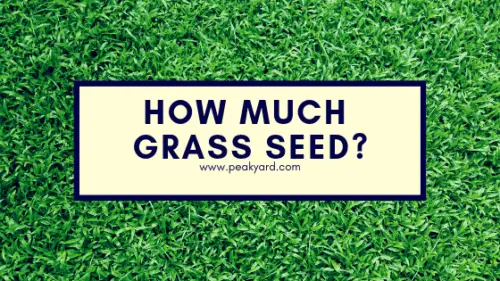Generally, grass seed is expensive. Getting the quantity right is essential if you are not interested in wasting money on excess seed. Additionally, it is important not to lay down too much or too little seed to avoid undesirable results.
While figuring out how much grass seed you need might seem complicated, it is really not that challenging once you do it a couple of times. Let’s take a look at how to determine how much seed you will need.
Table of Contents
Step 1: Measure
You will need to determine the square footage of the area you wish to seed. Pull out your tape measure and head out to the yard. You may want to bring a partner along to help with any long measurements.
To measure the area to be seeded, you simply measure the length, then the width, and then multiply the two figures together. So, if the desired area you wish to seed is 12 feet long by 12 feet wide, the square footage of this area is 144 (12 x 12).
As an alternative to a tape measure, there are online tools that can be used such as this Sod Solutions calculator. You type in your address and the tool allows you to calculate your lawn’s square footage based on an overhead map of your property.
It is best to use your manual measurements for the most accurate square footage calculation.
Step 2: Pick The Seed
The type of grass seed you buy will be a major factor in how much seed you need. Additionally, the type of seeding you are doing will also greatly matter. For example, seeding on bare soil will require more seed than overseeding over established grass.
Read the grass seed label or contact the manufacturer to determine the recommended pounds to apply. For example, this Pennington Smart Seed Sun & Shade recommends 6 pounds of seed/1000 sq. ft for new lawns or 3 pounds/1000 sq. feet for overseeding.
We recommend physically weighing the seed after you determine how much you need for your measured area. For example, if you are establishing a new lawn on topsoil measuring 500 square feet, you would weigh out 3 pounds of the Pennington Smart Seed Sun & Shade referenced above.
Step 3: Apply the Seed
To distribute the seed, you pour it into a spreader and set it to the recommend setting as indicated by the manufacturer. If you are unsure of the setting, you can set it to a low setting, and then keep passing over the seeding area until the seed you weighed is gone. The seed should be distributed in a uniform manner so that bare spots are not prevalent.
Step 3: Fertilize
While fertilizer is not technically a step in determining how much seed you need, it is an important topic to discuss. We highly recommend that you use a starter fertilizer such as Scotts Turf Builder Starter to help your new seed grow into a ticker lawn in less time. It is easy to skip this step since grass will grow, in most cases, without it. However, starter fertilizer provides the soil with both phosphorus and potassium, which greatly assist in building a strong grass root system. This healthy root system will help produce a lush, green lawn as the grass fully thickens. Similarly to grass seed, you will need to spread the starter fertilizer according to the recommendations on the bag.
Step 4: Water
We cannot put an emphasis enough on how important it is to water routinely when new seed is placed down. We recommend at least twice a day or potentially more in hot or windy conditions. The seeds should remain moist throughout the day, but not overly saturated with water. Too much water can cause the seed to wash away and too little water can dry out the seed to the point where it can potentially die. You ultimately want the soil to remain moist during the day without any pooling of water.
Conclusion
Measuring your lawn’s square footage is a laborious task, especially for a large yard. However, in order to save money and achieve desirable results, you need to put in the effort to obtain accurate measurements of your seeding area. This will improve your chances of growing your ideal lawn that your neighbor will envy.


